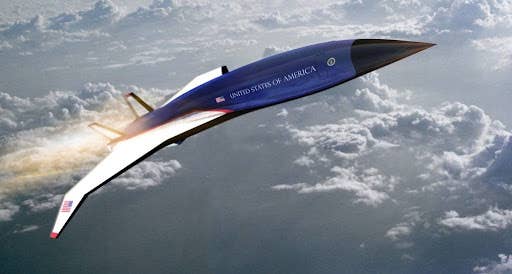
Engineers have unveiled a full-scale concept mockup of a hypersonic jet, which could be developed in the future to serve as Air Force One.
The airplane—dubbed Quarterhorse—is being developed by Atlanta-based startup Hermeus, which revealed the mockup Thursday during an exclusive event at an undisclosed location attended by company executives, investors, and the U.S. Air Force.
The Air Force is supporting the Quarterhorse project with a jointly funded, $60 million contract to develop an unprecedented hypersonic jet that could serve multiple roles, including military executive transport. Flying at Mach 5—more than 3,000 mph—would shrink flight time from New York to Paris from a typical seven hours to just 90 minutes.
Funding for Quarterhorse is coming from various venture capital sources as well as the Air Force Research Laboratory (AFRL), and the Air Force Life Cycle Management Center’s Presidential and Executive Airlift Directorate, which manages aircraft used by the President of the United States. Air Force aircraft carrying the president are code named Air Force One while they’re on board.
The project is part of a new push by the Air Force and Space Force to connect with high-technology startups via the Strategic Financing (StratFI) program. The contract with Hermeus is the first project under StratFI.
Hermeus’ Design
Quarterhorse’s design includes repurposed General Electric J85 turbofan jet engines that would be combined with proprietary ramjet technology now being developed by Hermeus.
The GE J85 design dates back to the 1950s, when it was first used to power Northrop’s T-38 Talon trainer and F-5 Freedom Fighter fighter jet. It boasts an 8-to-1 thrust-to-weight ratio, and, according to GE, the Air Force and NASA expect to keep the J85 in operational service until at least 2040.
The Quarterhorse mockup unveiled Thursday is not meant to fly, but to simply be used as a full-scale model to help engineers further develop the platform. Nonetheless, Hermeus outfitted the mockup with a jet engine and ignited it during the event, filling the air with a deafening roar.
“When an aerospace company typically unveils a new aircraft it’s nothing more than Styrofoam and fiberglass,” said Skyler Shuford, founder and COO, during the event. “But at Hermeus, we drive to [develop] integrated products. And we really, really like to make fire.” He also said the aircraft was designed and manufactured in four months.
It’s All About The Engine
Success for the program hinges on Hermeus’ turbine-based combined cycle (TBCC) engine.
Hermeus has been testing its subscale TBCC engine at its sea level static facility in Atlanta. During testing, the turbojet starts at low power and transitions to maximum thrust. That’s followed by the firing of the engine’s ramburner, which reaches maximum thrust before transitioning back to the turbojet-only operating mode. A ramjet uses only its own high-speed forward motion to compress air for combustion.
The three-year military contract comes with benchmark goals, such as:
- Flight testing a reusable hypersonic propulsion system
- Developing, building, and testing three Quarterhorse concept jets
- Creating a payload integration guide for future Quarterhorse flight testing
- Providing wargaming inputs for use in Air Force strategic analysis tools
Last March, Hermeus announced it had signed an agreement with NASA to evaluate technological maturity and exchange subject matter expertise to be applied directly to Hermeus’ engine design.
By the end of the flight-test campaign, Quarterhorse will be the fastest reusable aircraft in the world and the first of its kind to fly a TBCC engine, according to Hermeus.
Ultimately, the aircraft could be developed for use as a hypersonic military surveillance platform as well as for passenger transportation, Hermeus said.
Hermeus plans to develop the new aircraft by using an “iterative, hardware-rich” approach. The startup said the first working Quarterhorse prototype could start flight tests as soon as next year.
So this happened… 🔊 pic.twitter.com/TdvjAV44dz
— Hermeus (@hermeuscorp) November 9, 2021

Sign-up for newsletters & special offers!
Get the latest FLYING stories & special offers delivered directly to your inbox






